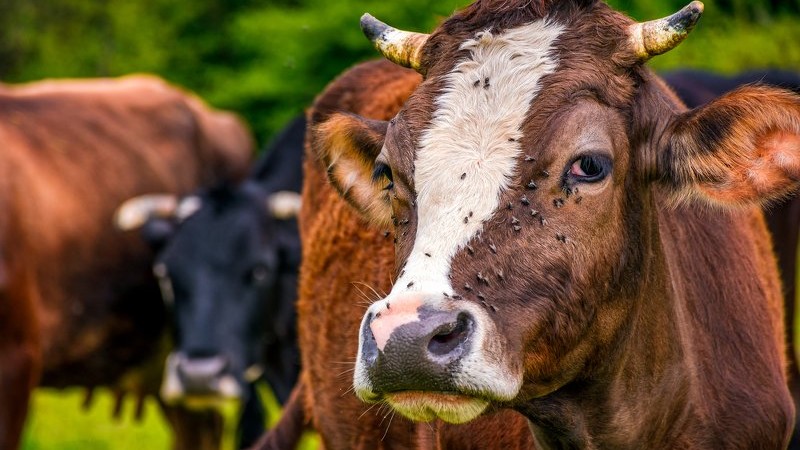

Flies not only cause irritation, but can also transmit disease. This may happen either mechanically, as a result of picking up micro-organisms while feeding, or by being a biological vector – an intermediary host for micro-organisms.
Culicoides midges are tiny insects, 1 mm to 3 mm in length. They occur in large numbers in late summer and autumn, when water is abundant. They breed along watercourses, and especially in low-lying vlei areas. Some also breed in fresh dung pads.
Animals grazing in these areas are at risk, especially from sundown to sunrise which is the midges’ most active time.
They can be avoided by using pyrethroids (Clout Pour-on, Triatix Plus); and vaccinating animals can prevent their getting the disease midges transmit.
Three-day stiff sickness (TDSS) is a viral disease of cattle transmitted by midges. The disease is prevalent during summer and autumn.
Clinical signs include fever, depression and stiffness, which usually last 3 days. This illness can be devastating in a dairy herd, causing severe loss in milk production. Heavy bulls could also be severely affected.
The disease can be prevented through vaccination, but the vaccine only gives partial immunity.
At-risk animals should be treated regularly with pyrethroid dips and pour-ons (Decatix 3, Ecobash, Decaspot 0.5%, Clout, Wipe Out and Triatix Plus Pour On). They should not graze in vlei areas during high-risk periods.
Culicoides midges can also transmit blue tongue to sheep.
And, as for TDSS, sheep grazing in vlei areas are most at risk. This is an economically important disease of sheep, as up to 30% of lambs could die and the survivors often suffer severe muscle damage, a break in the wool and lose weight.
Clinical signs are high fever, inflammation of nose and lips, progressing to erosions, severe swelling of the head and tongue, and – in severe cases – the feet are also affected, causing lameness
Vaccination is the preferred method of control. The vaccine contains 21 strains divided into 3 separate vaccines which have to be given separately at 3-week intervals, so time must be allowed for this vaccination programme before the peak blue tongue season in late summer.
Pregnant ewes cannot be vaccinated during the first half of pregnancy, so this must be allowed for in the vaccination programme.
Midge attacks can be reduced by avoiding vlei areas, and also by grazing cattle with sheep.
Certain mosquito species prefer livestock and breed in their millions during very heavy summer rain seasons.
These conditions are ideal for the transmission of the Rift Valley fever virus (RVF).
RVF is a disease of cattle, sheep and goats which causes abortion storms of 40% to 100%, and acute deaths of lambs and kids (30%).
Calves may also be affected, but to a lesser extent.
Vaccination is easy and economical and should be done before the summer season.
Stable flies (Stomoxys calcitrans) are biting, blood-sucking flies that cause problems in intensive systems such as dairies, pig units and poultry houses.They breed in compost heaps and manure.
The flies transmit diseases and cause severe irritation that leads to significantly lowered production of milk and meat. These flies transmit diseases such as lumpy skin disease (LSD) and anaplasmosis.
LSD is characterised by fever and depression followed by the characteristic lumps.
Stable flies can be controlled by using pyrethroid dips/pour-ons (Decaspot 0,5% Pour-on, Triatix Plus Pour-on, Decatix 3, Wipe Out, ECObash). LSD can also be controlled by vaccination.
House flies (Musca domestica) are non-biting flies that breed in manure and other organic material and occur in large numbers around houses and farmyards.
House flies cause annoyance which leads to a reduction in the milk yield and weight loss. They are mechanical transmitters of bacteria that cause mastitis and eye infections.
Moraxella bovis is one of the main causes of eye infections and flies can transmit it between cattle that are kraaled together.
Tetracyclines can be used to treat affected animals.
Face flies are small flies that follow cattle on the veld. The adult flies feed on wounds and eye discharges.
Face flies transmit Parafilaria bovicola, the cause of false bruising and bleeding spots. Infestations are easily treated with macrocyclic lactones (Ecomectin 1% injectable, Ecomectin Cattle Pour-on).
Face flies and house flies can be controlled by the application of pyrethroid-containing dips and sprays (Decaspot 0,5% Pour-on, Triatix Plus Pour-on, Decatix 3, Wipe Out, ECObash).
 Contact Jaguza Support
Contact Jaguza Support